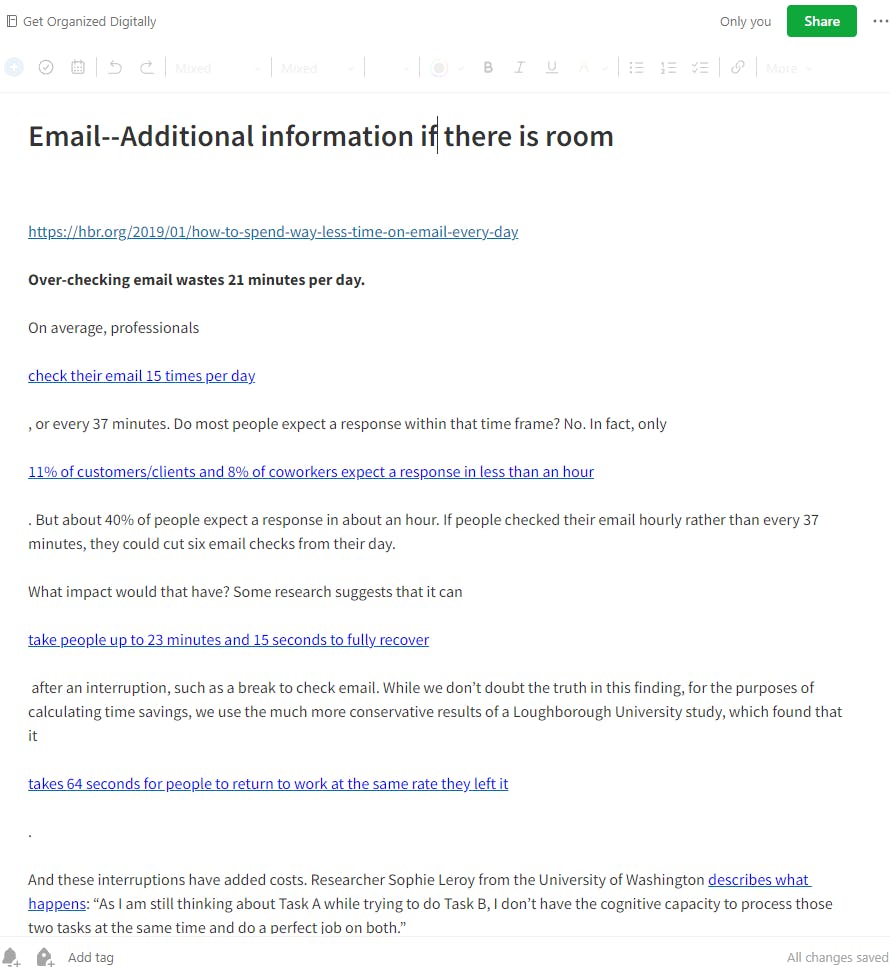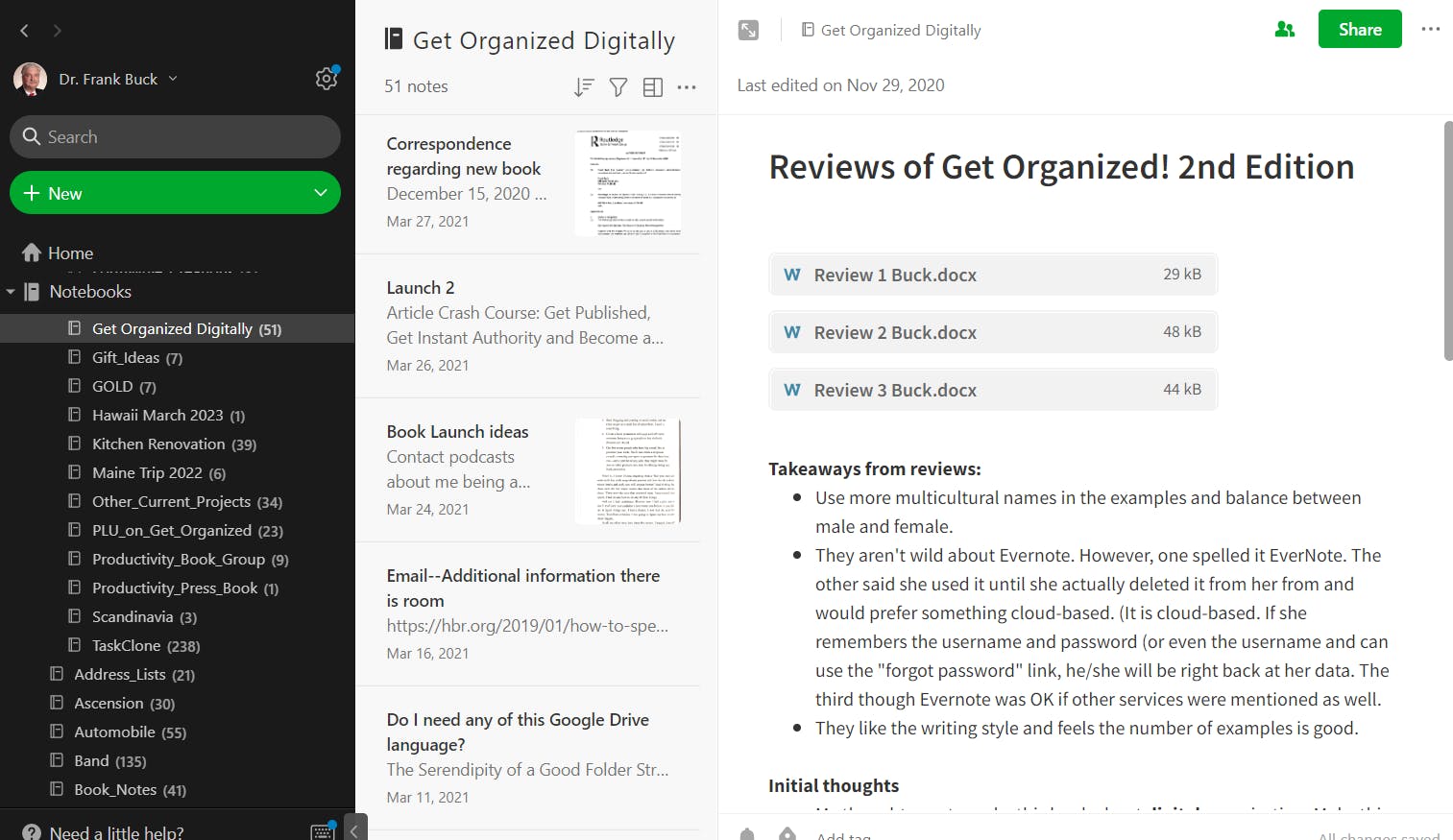Inside each of us is a story to tell.
Is “Someday, I’d like to write a book” a statement you’ve made? If so, this blog is written in the hope that your “someday” will be closer to today.
For me, the highlight of 2022 has been the release of my book “Get Organized Digitally!: The Educator’s Guide to Time Management.” Every step of the way, Evernote was close by, making sure no idea was lost and no deadline was missed.
It all starts with an idea
Ask an author about the idea that began a book. You’ll likely hear about some event that sparked the idea. And that’s the key. A book starts with an idea. The problem is ideas come at the most random times and in random places. If we’re not careful, that good idea slips away.

An example of a note to collect ideas as they come to you.
Create a notebook
If you have an idea for a book, go to Evernote and create a notebook. That “book” could even be a master’s thesis or doctoral dissertation. Create a note inside that notebook and pour your ideas into it. You’ll refine it later…but you can’t refine something you don’t have.

An example of organizing the flow of your work in a note.
Here’s how Evernote Expert Dave Edwards organizes his draft in Evernote:
“I begin by setting up a stack that will eventually contain all of my research as well as my first draft. I begin by preparing a rough outline of the book. I then conduct my research based on that outline. All of it goes into a ‘research’ folder in that stack. Once I have all of my research I begin tagging all of the research with the likely chapters where the information will fit.” — Dave Edwards
From ideas to polished prose
Nobody sits down at a blank screen and just starts writing a book—at least nobody I know. Ideas come at random times and in random places.
In the “old days,” an author might keep a good supply of index cards at hand. A new idea meant pulling out a blank card and putting that idea on it. Put the cards in order, and there’s the foundation for the book.
In Evernote, create a note for each chapter you foresee. As ideas come, open the appropriate note and add the idea. Using voice input is especially easy. Open the note on your phone, tap the microphone key on the keyboard, and start talking.
What about images?
I learned with my first book that images are created separately from the text of the book. In the finished manuscript you submit, you’ll have notations such this: <Insert Figure 5.3 about here.>
What has worked well for me is to create a PowerPoint deck for the figures and images. I create a slide for each image and insert a text block along with the image indicating the number and title of that item.
In Evernote, you can plan what figures you’ll include. Evernote even allows you to add a sketch to a note. Sketch your intentions with your finger to serve as a reminder of what you want the finished product to look like.
Put it in order
In your notebook, you have a note for each chapter. Periodically, improve each note. Cut and paste your ideas so they start to appear in a logical order.
Now start writing
When each note contains a fairly detailed outline of what you want in the chapter, it’s time to write. You’ll want to create a new note for each chapter. Your final submission will also be a separate document for each chapter.
Then, start editing and turning the ideas into sentences.
“Evernote helps me organize my books and create flexibility in the writing structure. It is complex enough without the overwhelming complexity of some systems that lets me stay in the creative process.” — Evernote Expert JB Glossinger
When you’re done writing, you’ve just begun
When you put the last period on the last sentence of the last page, a little voice inside says, “Done!” You’ve simply completed one part of the project. Granted, the writing is the most important part, but you’re looking at another six months to a year before you’ll hold a copy of the book in your hand.

Who will publish it?
The space here is far too small to list possible publishing companies and names of contacts and sample pitches. All of that could be an entire book in itself. You’ll find much of that as you read relevant articles, listen to podcasts on the subject, and talk to published authors. The information is plentiful.
The question, however, is how you are going to trap that good information so you can find it when you need it. Create a note for each publisher you are considering. As you come across requirements for pitches, you’ll have a place to put that information.
As you correspond with publishers, you’ll want to save what you send to them and what they send to you. Forward that information to Evernote. With a paid Evernote account, you get an email address that allows you to forward any email and have it create a new note within Evernote.
Keep it all organized
What comes next is lots of back-and-forth communication with your publisher. You’ll be introduced to different people. Each one helps with a part of the process.
You’ll want to keep up with the name and contact information for each person. Save email correspondence to and from these people. Evernote is the place to do that. Here’s how.
There’s a cover to design, and the publisher will help with that. Provide your ideas and let their designers put together some options for you to view. Save all the options in Evernote.
A professional proofreader will go through your manuscript with a fine-toothed comb. You’ll have correspondence between the two of you that you’ll save.

Light at the end of the tunnel, or a new tunnel?
Success! You have a date when the book will be published. But that date doesn’t mark “the end.” Instead, it’s an important date in your marketing.
How are people going to know about your new book? The publisher is working with many authors, so you can’t assume marketing is being done for you.
Many podcasters are looking for guests. You’ll gain ideas for podcasters or people in traditional media you’ll want to contact. Start a note in Evernote where you’ll list the contact information.
When you get a commitment from someone such as a podcast host, create a new note. Add the contact information. Start listing questions you would like to be asked, along with an outline of your answers. The host will likely have a few questions they ask all guests. Put those in the note and craft your answers.
Add correspondence between you and the host into the note. When the segment airs, put the URL for it in the note as well.
You have a story to tell
Don’t allow a great story to remain untold because of a long and detailed process. Writing a book doesn’t have to be that hard. Evernote helps you to capture the smallest details, regardless of where ideas occur, and make your book a reality.
What’s your story? Create a notebook in Evernote and start a notebook and an adventure.
“As a professor, writing is an integral part of my work. Evernote supports every project task for a multi-edition textbook, from proposal to publication. It enables capturing from many sources, organizing chapter content, linking topics across chapters, and sharing drafts with colleagues and editors. Indispensable!” — Dr. Jack McGourty
